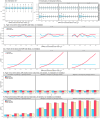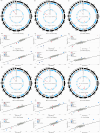An approach to identify gene-environment interactions and reveal new biological insight in complex traits
- PMID: 38649715
- PMCID: PMC11035594
- DOI: 10.1038/s41467-024-47806-3
An approach to identify gene-environment interactions and reveal new biological insight in complex traits
Abstract
There is a long-standing debate about the magnitude of the contribution of gene-environment interactions to phenotypic variations of complex traits owing to the low statistical power and few reported interactions to date. To address this issue, the Gene-Lifestyle Interactions Working Group within the Cohorts for Heart and Aging Research in Genetic Epidemiology Consortium has been spearheading efforts to investigate G × E in large and diverse samples through meta-analysis. Here, we present a powerful new approach to screen for interactions across the genome, an approach that shares substantial similarity to the Mendelian randomization framework. We identify and confirm 5 loci (6 independent signals) interacted with either cigarette smoking or alcohol consumption for serum lipids, and empirically demonstrate that interaction and mediation are the major contributors to genetic effect size heterogeneity across populations. The estimated lower bound of the interaction and environmentally mediated heritability is significant (P < 0.02) for low-density lipoprotein cholesterol and triglycerides in Cross-Population data. Our study improves the understanding of the genetic architecture and environmental contributions to complex traits.
© 2024. The Author(s).
Conflict of interest statement
The authors declare no competing interests.
Figures





Update of
-
A new Approach to Identify Gene-Environment Interactions and Reveal New Biological Insight in Complex traits.Res Sq [Preprint]. 2023 Oct 5:rs.3.rs-3338723. doi: 10.21203/rs.3.rs-3338723/v1. Res Sq. 2023. Update in: Nat Commun. 2024 Apr 22;15(1):3385. doi: 10.1038/s41467-024-47806-3. PMID: 37886448 Free PMC article. Updated. Preprint.
Similar articles
-
A new Approach to Identify Gene-Environment Interactions and Reveal New Biological Insight in Complex traits.Res Sq [Preprint]. 2023 Oct 5:rs.3.rs-3338723. doi: 10.21203/rs.3.rs-3338723/v1. Res Sq. 2023. Update in: Nat Commun. 2024 Apr 22;15(1):3385. doi: 10.1038/s41467-024-47806-3. PMID: 37886448 Free PMC article. Updated. Preprint.
-
Role of Rare and Low-Frequency Variants in Gene-Alcohol Interactions on Plasma Lipid Levels.Circ Genom Precis Med. 2020 Aug;13(4):e002772. doi: 10.1161/CIRCGEN.119.002772. Epub 2020 Jun 8. Circ Genom Precis Med. 2020. PMID: 32510982 Free PMC article.
-
Evaluating the relationship between circulating lipoprotein lipids and apolipoproteins with risk of coronary heart disease: A multivariable Mendelian randomisation analysis.PLoS Med. 2020 Mar 23;17(3):e1003062. doi: 10.1371/journal.pmed.1003062. eCollection 2020 Mar. PLoS Med. 2020. PMID: 32203549 Free PMC article.
-
Genotype × environment interactions in gene regulation and complex traits.Nat Genet. 2024 Jun;56(6):1057-1068. doi: 10.1038/s41588-024-01776-w. Epub 2024 Jun 10. Nat Genet. 2024. PMID: 38858456 Review.
-
Progress and promise of genome-wide association studies for human complex trait genetics.Genetics. 2011 Feb;187(2):367-83. doi: 10.1534/genetics.110.120907. Epub 2010 Nov 29. Genetics. 2011. PMID: 21115973 Free PMC article. Review.
Cited by
-
Accounting for heterogeneity due to environmental sources in meta-analysis of genome-wide association studies.Commun Biol. 2024 Nov 14;7(1):1512. doi: 10.1038/s42003-024-07236-9. Commun Biol. 2024. PMID: 39543362 Free PMC article.
-
LDER-GE estimates phenotypic variance component of gene-environment interactions in human complex traits accurately with GE interaction summary statistics and full LD information.Brief Bioinform. 2024 May 23;25(4):bbae335. doi: 10.1093/bib/bbae335. Brief Bioinform. 2024. PMID: 38980374 Free PMC article.
-
The Garden of Forking Paths: Reinterpreting Haseman-Elston Regression for a Genotype-by-Environment Model.Behav Genet. 2024 Jul;54(4):342-352. doi: 10.1007/s10519-024-10184-z. Epub 2024 Jun 18. Behav Genet. 2024. PMID: 38888866 Free PMC article.
-
Investigating the Role of Neighborhood Socioeconomic Status and Germline Genetics on Prostate Cancer Risk.medRxiv [Preprint]. 2024 Aug 2:2024.07.31.24311312. doi: 10.1101/2024.07.31.24311312. medRxiv. 2024. PMID: 39132496 Free PMC article. Preprint.
References
Publication types
MeSH terms
Substances
Grants and funding
LinkOut - more resources
Full Text Sources

